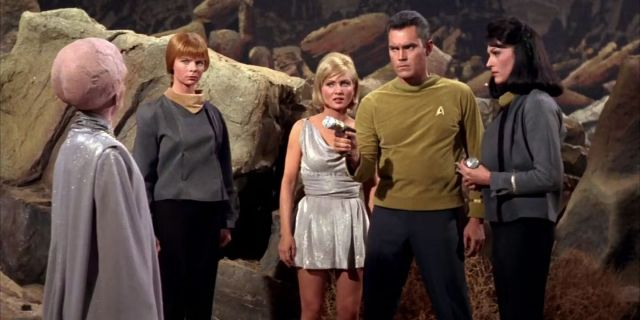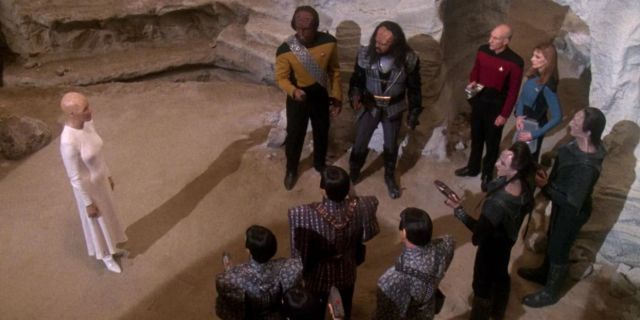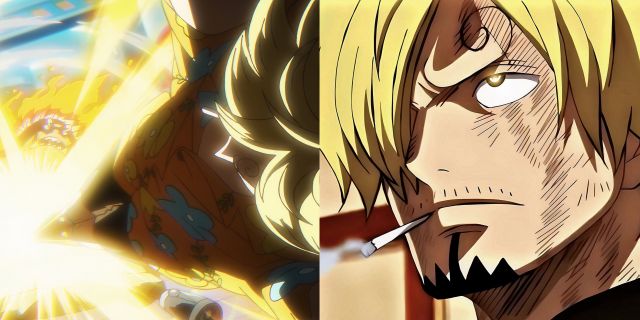Star Trek stories frequently tackle big questions. Individual episodes can work through everything from personal romantic relationships to intergalactic war. Most stories are character-driven, but modern takes on the franchise tend to deal with massive movements in society and culture. Star Trek: Discovery made a few key callbacks to early ideas, expanding concepts that might not have received the spotlight. One such example explores the Progenitors, the unique alien species that created humanity.
Star Trek has very different goals in the modern era. Old seasons could tell short, episodic stories that wrapped up as the credits rolled. Streaming services and modern networks want shows that must be watched in a specific order, promoting the binge model or guaranteeing return customers. Shows like Star Trek: Discovery live and die on cliffhangers and “previously on” segments. Story elements like the Progenitors work well for either model.
Who were the Progenitors?

The Progenitors were the common ancestors of almost all sentient life in the Star Trek universe. They’re humanoid aliens with several unusual physical traits. They have no hair on their bodies. They’re bald with no eyebrows, making them look simultaneously ancient and newborn. Their eyes look just like human eyes, but they’re extremely deep-set in their skulls. They have long, oddly-shaped heads with tiny ears. The first Progenitors depicted in Star Trek are extremely pale. Their pink skin has a slightly sickly appearance. Newer examples sometimes have black skin. Their appearance is unusual, but they behave much like human beings in their limited appearances. The Progenitors would have been one of the first sentient species in the galaxy. Aspects of their design likely influenced that of several other species.
The Progenitors came into existence around 4.5 billion years ago. They evolved on an unnamed planet and gradually developed into an early sentient species. They were likely the first humanoid beings in the galaxy. With their increased intelligence, they reasoned that their time in the universe would be finite. They deduced that every species had a shelf life and none could expect to go on forever. Subsequently, they set to work creating the next several generations of life in the universe. The Progenitors seeded several planets across the universe with specially-crafted DNA samples. Their contributions to the primoridial soup gradually developed into new sentient species. Earth was one of their targets, eventually resulting in the human race. They probably laid forth the genetic material that would become almost every other notable Star Trek species. The same group that created humanity likely built the Cardassians, Vulcans, Klingons, and Romulans.
Where did the Progenitors first appear?

|
Episode Title |
“The Chase” |
|---|---|
|
Episode Number |
The Next Generation Season 6, Episode 20 |
|
Director |
Johnathan Frakes |
|
Writers |
Ronald D. Moore and Joe Menorsky |
|
Release Date |
April 26, 1993 |
The Progenitors’ debut comes in a Star Trek: The Next Generation episode called “The Chase.” The twentieth episode of the sixth season depicts Picard working to finish the final project of his old archeology teacher. Picard’s beloved mentor dies after an unexpected attack, leaving Picard to struggle with his studies. He finds DNA evidence to suggest a distant connection between many different species. While traveling to the professor’s next destination, Picard and the crew encounter Klingon and Cardassian vessels. They agree to work together despite expecting different treasures at the end of the journey. The Cardassians try to sabotage the Enterprise, but Picard works with the Klingons to find the hidden destination. The Romulans and Cardassians reach the location just in time to see Picard and Dr. Crusher solves the puzzle by scanning a sea-bed. The resulting solution plays a hologram of a Progenitor who explains the history of their species. It’s an in-universe explanation of why so many unique beings in Star Trek are rubber-forehead aliens. The Progenitor ends their message hoping that the knowledge of every species’ shared heritage might bring peace. The Klingons and Cardassians seem angry, but Picard seems hopeful.
What happened to the Progenitors’ machines?
Star Trek: Discovery resurrected the Progenitors for a new storyline. This new take on the material unpacked the machinery that the Progenitors used to seed planets with DNA. The show depicts scientists finding that technology. Betazoid neuroscientist Marina Derex discovers a portal that allows her to communicate with a Progenitor, left behind in a liminal space to guide future generations. Derex believed that the existing species weren’t ready for this responsibility, promising to work toward a better future on the Progenitor’s behalf. The scientists buried every piece of evidence, saving the critical information for some unknown upcoming era. In the 32nd century, Michael Burnham finds the same portal and chats with the same Progenitor. That alien voice explains that their species didn’t invent the technology, but merely discovered it as she had. Something must have invented that technology and used it to create the Progenitors. The Progenitor trusts Burnham with the portal, and she sends it into a black hole, burying the secrets even deeper.
The Progenitors are a fascinating science fiction idea that could have been explored more. Star Trek: Discovery didn’t have the same message behind their inclusion of this unique species. The Next Generation used a common creator to argue for peace. Discovery used the promise of advanced technology to add more questions. It’s a bizarre new take on the premise.











Leave a Reply